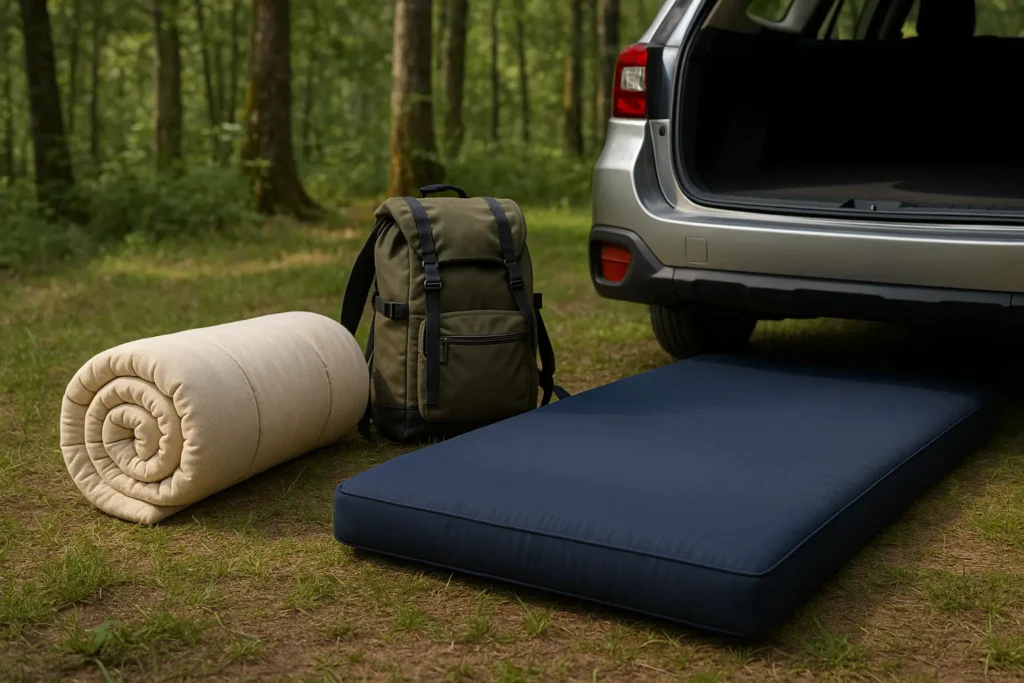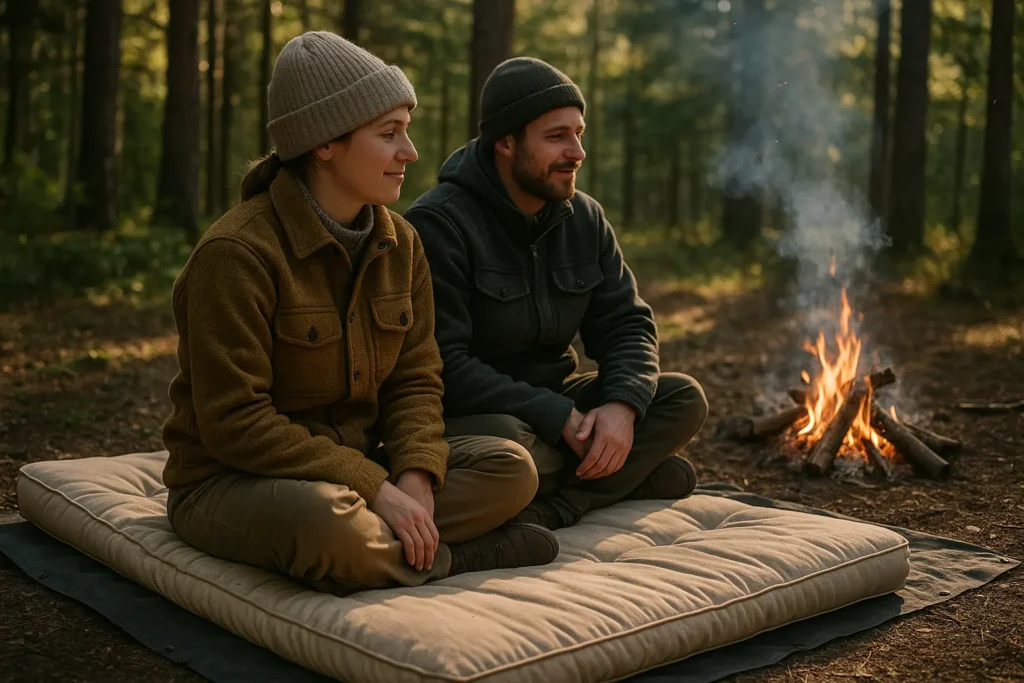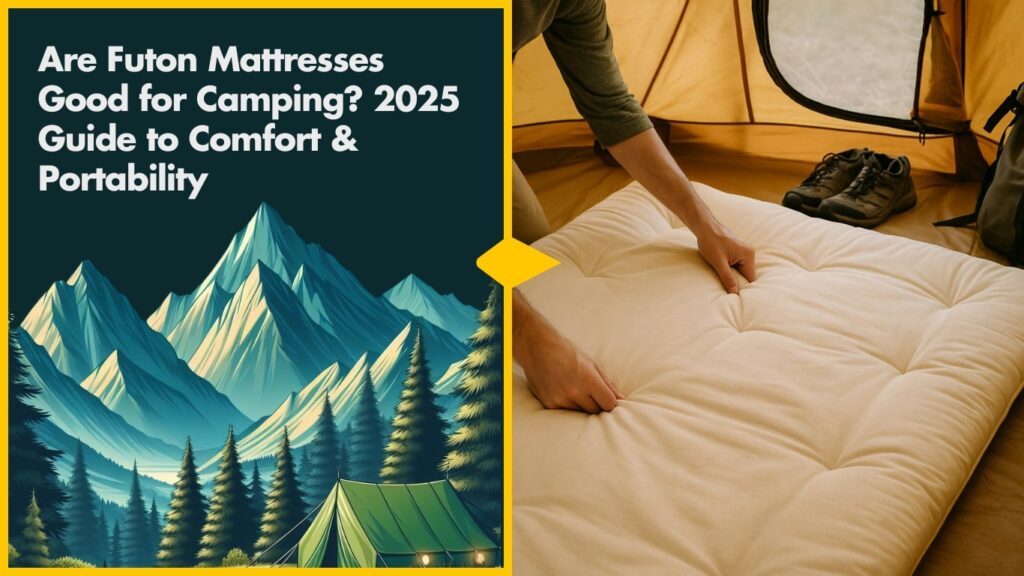Camping is an amazing escape but let’s be honest, sleeping on the ground can be rough. I have tried air mattresses, foam mattresses, sleeping pads, even blankets. Then I discovered futon mattresses for camping, and it completely changed how I sleep outdoors.
Whether you’re into car camping, backpacking, or tent setups, a portable futon especially a Shikibuton— offers real comfort, packs easily, and doesn’t leave you waking up sore. These foldable mattresses for camping are a game-changer for serious campers.
In this 2025 guide, we’re going to explore whether or not futon mattresses are good for camping, how futons compare to air mattresses and sleeping pads. We’ll also give you tips for picking the best futon mattress for your next adventure. If camping sleep comfort matters to you, keep reading.
What Is a Futon Mattress?
Before deciding if a futon mattress is good for camping, it helps to understand what makes it unique. After camping through forests, deserts, and mountain ranges, I’ve learned that the right sleeping setup can make or break your trip—and futons offer a solid middle ground between comfort and portability.
Traditional vs. Western Futons
If you are new to futon mattresses for camping, it’s helpful to know that there are two main types and they’re pretty different in how they feel and function.
- Traditional Japanese futons, also called Shikibutons. These are thin usually around 2 to 3 inches and made with natural materials like cotton or wool. What I love about them is how easy they are to roll up and pack. They’re lightweight and ideal for minimalist setups—perfect for backpacking or tight tent spaces.
- Western futons, on the other hand, are thicker (4–8 inches) and often include memory foam, springs, or a hybrid mix of materials. They’re definitely heavier—but they offer serious comfort, especially for car camping setups.

Both types are foldable mattresses for camping, so it really comes down to your trip. If you’re trying to pack light, a traditional futon might be the way to go. If you want hotel-like comfort in the woods, go Western.
Why Futon Mattresses Work for Camping
If you’re tired of thin sleeping pads or deflating air mattresses, a futon for outdoor sleeping might be your answer. They offer more padding and pressure relief, which helps reduce soreness in your back, hips, and shoulders—especially for side and back sleepers.
Compared to some setups, futons also make it easier to move or get up without waking others. That’s a win for shared tents or family trips.
And yes, they’re built for comfort—some campers even say camping with a memory foam futon feels almost like sleeping at home.
Key Features of Futon Mattresses for Camping
If you’re looking for a comfortable camping mattress that’s supportive, foldable, and easy to transport, a futon is worth considering.
- Portability: Traditional futons (15–30 lbs) roll up tight and are easy to fit in your car—great for quick setups. Western futons (30–50 lbs) are bulkier but perfect for car camping comfort.
- Versatility: They’re not just for sleeping. You can also use a futon as a lounge pad or even extra seating around the campfire.
- Firmness: Most futons are medium-firm (6–8/10), offering solid spinal support and better comfort than most air mattresses—especially for side and back sleepers.
- Materials: Pick from cotton (breathable), wool (insulating), memory foam (contouring), or organic hybrid options if you want something eco-friendly futon materials.
Benefits of Using Futon Mattresses for Camping
After testing all kinds of bedding—from inflatable mats to memory foam pads—futon mattresses for camping have easily become one of my favorite options. Here’s why they stand out during multi-day trips.
1. Comfort and Support
Let’s start with the biggest reason: comfort. Unlike air mattresses that deflate overnight or thin pads that bottom out, futons offer consistent, firm support. Whether made with cotton, wool, or memory foam, their layers help distribute weight evenly and reduce pressure on your hips and shoulders.
If you’re a side or back sleeper like me, this firmness (usually around 6–8 out of 10) promotes better spinal alignment—which makes a huge difference after a long hike. In fact, a 2024 Outdoor Life gear study found that firm bedding like Shikibuton camping mattresses helped reduce morning aches compared to softer air mattresses.
2. Portability and Storage
A lot of people assume futons are bulky, but that’s not always true. Traditional futons (especially Shikibutons) can weigh as little as 15 lbs and roll up tightly, making them perfect for compact transport. Even Western futons, though heavier, often come with straps or handles, making them manageable for car camping.
During a recent Yosemite trip, I packed a 4-inch cotton futon in my SUV—it actually took up less space than my old air pump and mattress combo. Once rolled, it fit neatly in the tent corner and didn’t clutter the campsite.
3. Versatility at Camp
Another win: futons are more than just sleeping gear. I’ve used mine as a seat during campfire chats, a soft spot for afternoon naps, and even a mat for stargazing. A good foldable mattress for camping gives you more than just a place to crash—it becomes part of your everyday campsite comfort.

This makes futons perfect for families, group trips, or anyone who wants multi-functional gear without lugging around extra padding.
4. Durability
Quality futons are built to last—especially ones made with organic materials like cotton or wool. Unlike air mattresses that can puncture on rocky ground (I’ve had that nightmare mid-trip), futons hold up well when paired with a ground tarp or waterproof cover.
In fact, a recent 2025 gear review by REI Co-op pointed out that cotton-based camping mattresses tend to outlast many synthetic pads, as long as you keep them dry and properly stored.
Drawbacks of Futon Mattresses for Camping
While futon mattresses for camping offer serious comfort, they’re not the perfect fit for every camper or trip. After testing them out myself—and hearing from others in communities like r/camping—here are a few downsides you should know before packing one up.
1. Weight and Bulk
Even lightweight Shikibutons can weigh 15–30 lbs, which is much heavier than ultralight sleeping pads (some under 5 lbs). For backpacking, that added weight makes them a tough sell. Western futons—especially memory foam or hybrid futons—can hit 30–50 lbs and take up a lot of space.
I remember one group trip where a friend tried to fit a thick camping mattress in the trunk of her compact car—it barely fit. Definitely a better option for car camping, not hauling up trails.
2. Moisture Sensitivity
Materials like cotton and wool are cozy, but they also soak up moisture. On a damp trip through Oregon, I skipped the waterproof cover and came back to a soggy, musty futon. Lesson learned: always bring a ground tarp and use a water-resistant barrier, especially in humid or rainy conditions.
3. Too Firm for Some Sleepers
While many campers (including me) appreciate the firmness for pressure relief, some people—especially lighter side sleepers—might find futons too hard. According to a 2024 Sleep Foundation survey, about 20% of campers said futons felt less comfortable than air mattresses.
If you prefer something softer, try adding a mattress topper—though keep in mind it adds more bulk to your setup.
4. Setup and Storage Can Be a Hassle
Unlike self-inflating camping mattresses, futons need to be manually unrolled and arranged, which can feel like a chore after a long hike. Thicker Western futons also take time and effort to roll back up neatly.
After a few frustrating setups, I started practicing the roll-up at home. It sounds silly, but it really sped things up at camp.
While futons have their limitations, they’re still a solid choice for those prioritizing camping sleep comfort over weight savings. Just be mindful of your space, sleep style, and the weather before making the switch.
Alternatives to Futon Mattresses for Camping
If a futon mattress for camping isn’t the right fit for you, here are a few solid alternatives I’ve tried over the years—each with its own pros and ideal use cases:
| Alternative | Best For | Key Features & Considerations |
|---|---|---|
| Self-Inflating Sleeping Pads | Backpacking, minimalist campers | Super lightweight (1–5 lbs), compact, and easy to set up. Brands like Therm-a-Rest offer 2–4″ thick models. Less versatile than futons but great for travel. |
| Air Mattresses | Car camping, adjustable comfort | Portable and plush, but prone to punctures. 2025 Camping World review says high-end models rival futons—but need a power source for inflation. |
| Foam Mattress Toppers | Stationary camps, extra padding | Adds softness to cots or firm ground. Not very portable—better for longer stays or drive-in campsites. |
Each of these camping bedding options has strengths depending on your setup style. I’ve used them all at different times, but a futon for outdoor sleeping still wins for comfort and multi-use versatility on car camping trips.
Conclusion
Futon mattresses for camping offer a unique blend of comfort, versatility, and durability—especially for car campers looking for a more supportive and multi-purpose sleep setup. Their firm support is great for back and side sleepers, and their ability to double as a lounge pad or extra seating adds serious value at camp.
That said, futons aren’t perfect for every trip. Their weight and moisture sensitivity make them less ideal for backpacking or wet weather. But with the right gear—like a ground tarp, waterproof cover, and maybe a mattress topper—you can build a cozy, reliable sleep setup that beats a thin pad or deflating air bed any day.
Whether you go with a traditional Shikibuton or a cushier Western futon, be sure to test it at home before your next adventure. A little prep goes a long way toward a better night’s sleep in the wild.
Have questions about using a futon for your next camping trip? Check out our FAQs below or Comment for others…
